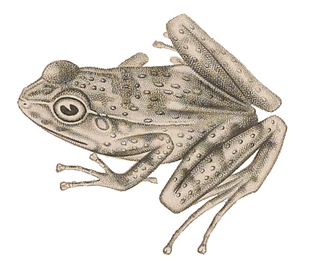Boana latistriata is a species of frog in the family Hylidae. It is endemic to Brazil and only known from its type locality, Itatiaia National Park, and from Marmelópolis, both in the state of Minas Gerais. The specific name latistriata refers to the wide stripes on the back of this frog.

Crossodactylus is a genus of frogs in the family Hylodidae. The genus occurs in Brazil, southern Paraguay, and northern Argentina. These frogs are sometimes known as Limnocharis, Tarsopterus, Calamobates, and by the common name spinythumb frogs. They typically inhabit streams in mountainous areas in the Atlantic Forest or in montane savanna.

Crossodactylus dantei or the Murici spinythumb frog, is a species of frog in the family Hylodidae. It is endemic to Brazil. Scientists know it exclusively from the type locality: Murici, in Alagoas. Its natural habitats are subtropical or tropical moist lowland forest and rivers. It is threatened by habitat loss.
Crossodactylus dispar is a species of frog in the family Hylodidae. It is endemic to Brazil. Its natural habitats are subtropical or tropical moist lowland forest, subtropical or tropical moist montane forest, and rivers. It is threatened by habitat loss.

Crossodactylus gaudichaudii is a species of frog in the family Hylodidae. The species is endemic to Brazil.
Crossodactylus grandis, or the Bahia spinythumb frog, is a species of frog in the family Hylodidae. It is endemic to Brazil. Its natural habitats are subtropical or tropical high-altitude grassland and rivers. It is known solely from the Parque Nacional do Itatiaia in Minas Gerais in Brazil, where it lives in cloud forests. It is threatened by habitat loss.
Crossodactylus lutzorum is a species of frog in the family Hylodidae. It is endemic to Brazil. Scientists know it exclusively from the type locality: Fazenda Água Branca in Bahia. Its natural habitats are subtropical or tropical moist lowland forest and rivers. It is threatened by habitat loss.
Crossodactylus schmidti or Schmidt's spinythumb frog is a species of frog in the family Hylodidae. It is found in Argentina, Brazil, and Paraguay. Its natural habitats are subtropical or tropical moist lowland forest and rivers. People have seen it between 300 and 750 meters above sea level. It is threatened by habitat loss.
Crossodactylus trachystomus is a species of frog in the family Hylodidae. It is endemic to the Espinhaço Mountains in Minas Gerais, Brazil.
Phantasmarana jordanensis is a species of frog in the family Hylodidae. It is endemic to southeastern Brazil and only known from its type locality, Campos do Jordão in the São Paulo state. Its natural habitat is forest at 1,700 m (5,600 ft) asl.
Hylodes uai is a species of frog in the family Hylodidae. It is endemic to the Espinhaço Mountains in the Minas Gerais state, Brazil, where it is known from the Mangabeiras Park in Belo Horizonte, and another location on the southern end of the Espinhaço Mountains. It is the most-inland species of the genus.
Hylodes vanzolinii is a species of frog in the family Hylodidae.

Odontophrynus cultripes is a species of frog in the family Odontophrynidae. It is endemic to southeastern Brazil and known from Minas Gerais, Goiás, and São Paulo states. It is mostly found at altitudes higher than 800 m (2,600 ft) above sea level.

Proceratophrys schirchi is a species of frog in the family Odontophrynidae. It is endemic to eastern Brazil and occurs in southeastern Bahia, Espírito Santo, northeastern Minas Gerais, and Rio de Janeiro states. The specific name schirchi honours Paulo F. Schirch, a Brazilian zoologist who collected the type series. Common names Santo smooth horned frog and Brazilian smooth horned frog can refer to this species, the latter specifically referring to Proceratophrys precrenulata that is now considered a junior synonym only.
Hylodes perere is a species of frog in the family Hylodidae. It is endemic to Brazil and only known from Serra Negra, a part of Mantiqueira Mountains, in Santa Bárbara do Monte Verde, Minas Gerais state. The specific name perere is derived from a character in Indian folklore who guards the forest, disrupting its silence with its whistles—in reference to the vocalizations of this species.

Hylodidae, commonly known as giant Neotropical torrent frogs, is a family of frogs native to Brazil and northern Argentina. Phylogenetic evidence suggests the Hylodidae being the sister group to the Alsodidae.
Crossodactylus boulengeri is a species of frog in the family Hylodidae. It lives in the Serra do Mar mountain range in São Paulo and Rio de Janeiro in Brazil.
Crossodactylus cyclospinus is a species of frog in the family Hylodidae. It is endemic to Brazil and has been observed in two localities in Minas Gerais, both on the Jequitinhonha River.
Crossodactylus timbuhy is a species of frog in the family Hylodidae. It is endemic to Brazil. It has been observed near Santa Teresa in Espírito Santo.
Crossodactylus werneri is a species of frog in the family Hylodidae. It is endemic to Brazil. It has been observed in parts of Serra da Mantiqueira stretching through Minas Gerais, Rio de Janeiro, and São Paulo.





